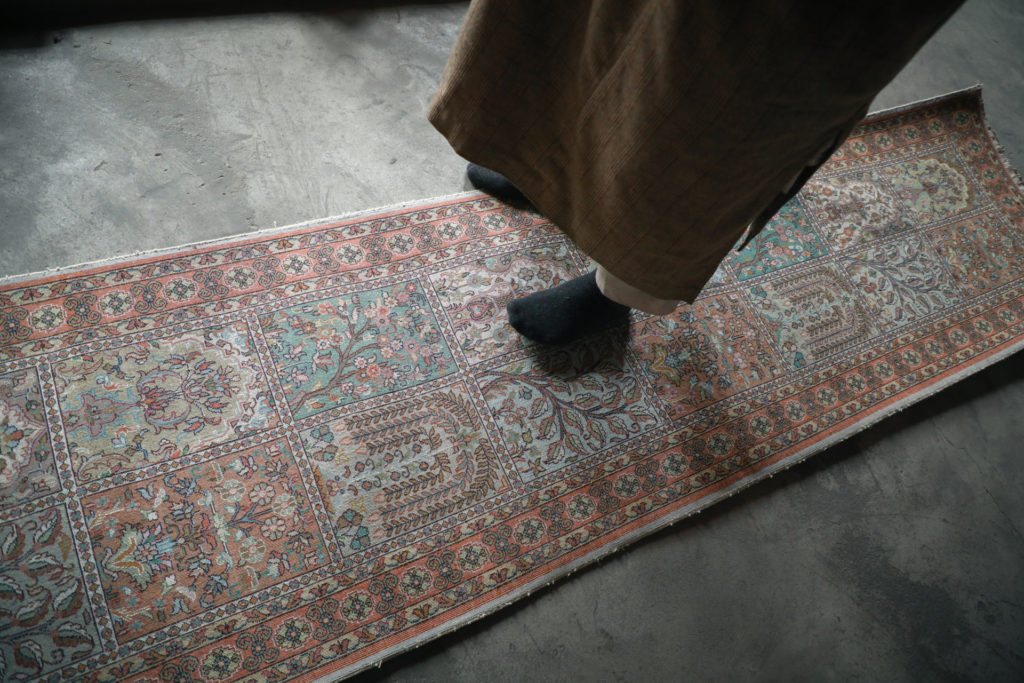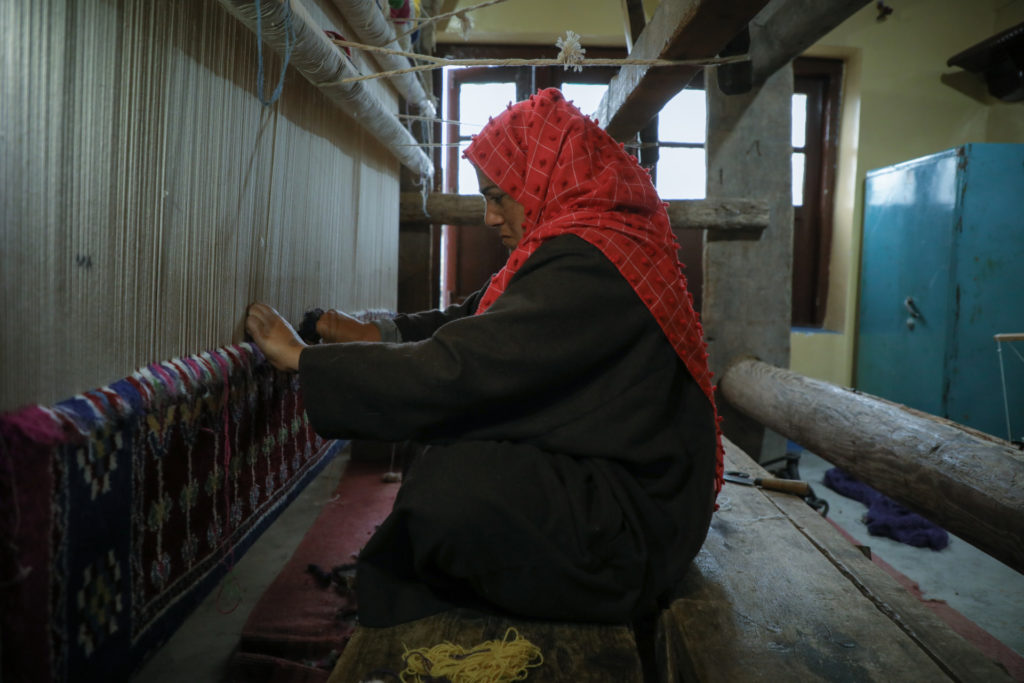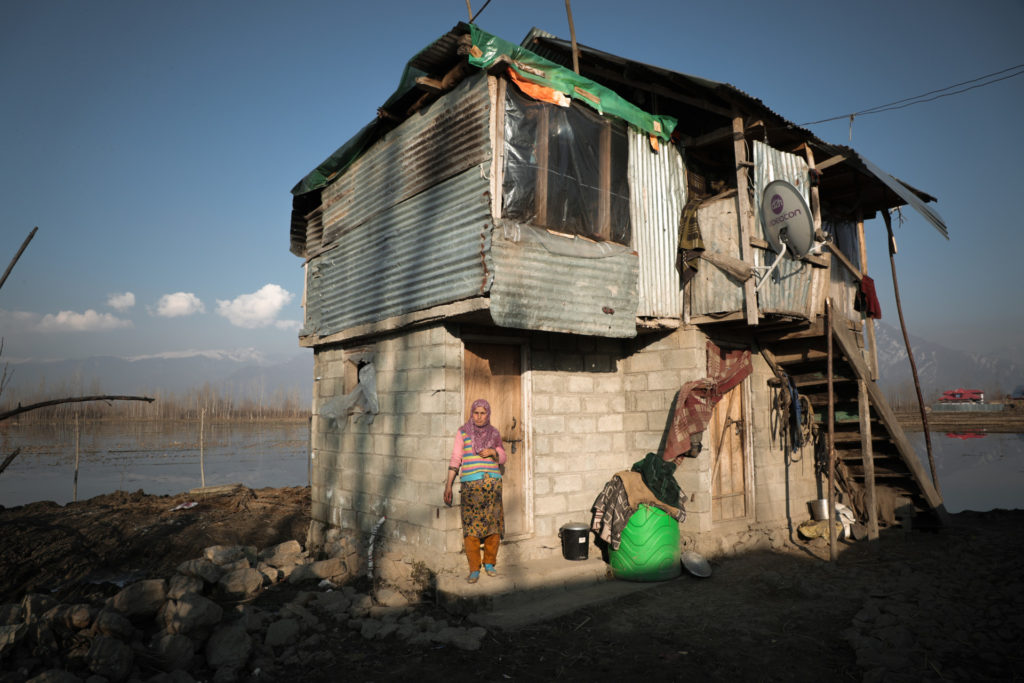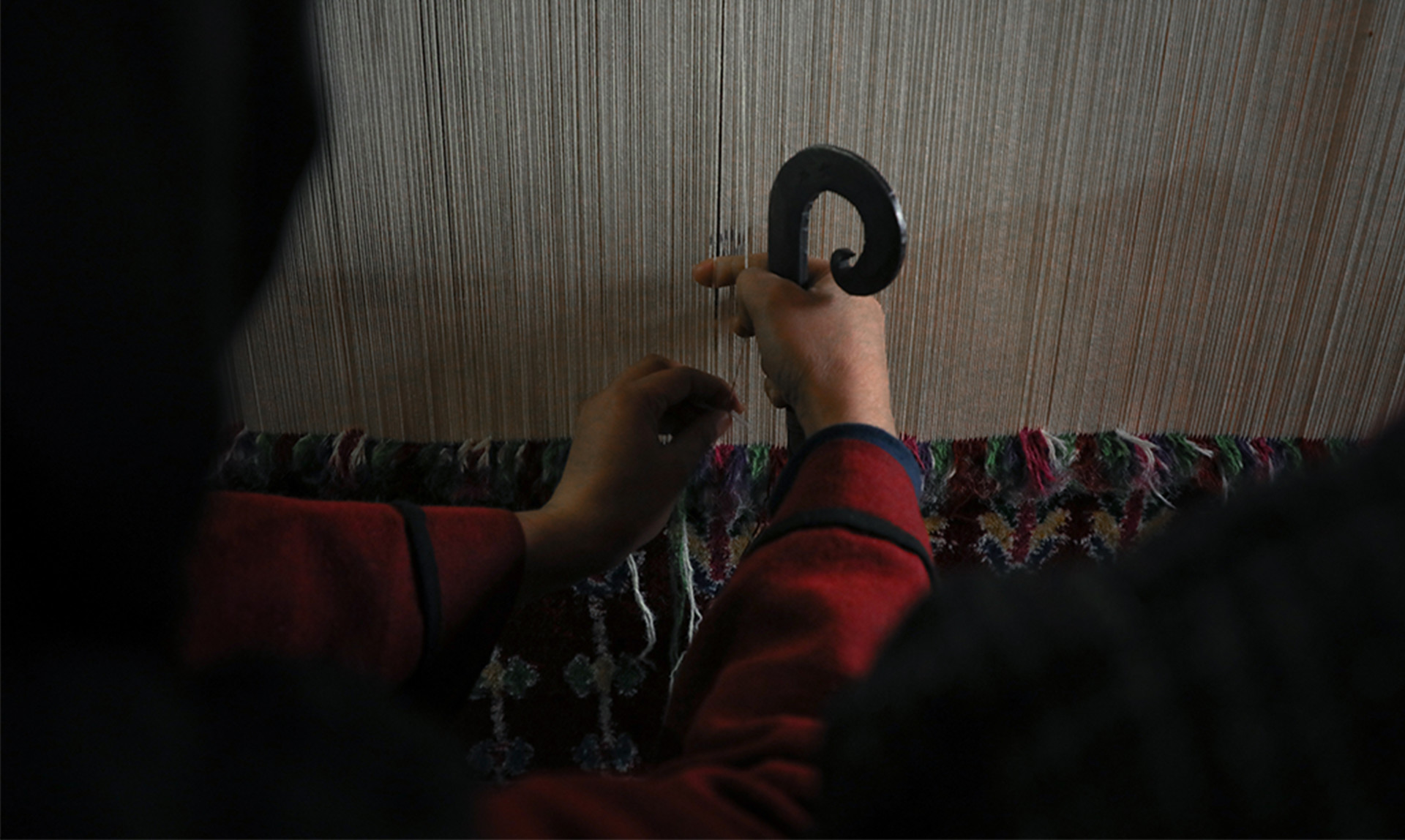Ven Zamrooda lives in a single-story house that she transformed long ago into a work-from-home carpet weaving business. She doesn’t know her precise age but estimates herself to be in her “late 30s.” Like many women in her village of Vijpara, located in the north of Kashmir about 50 kilometers (31 miles) from the capital Srinagar, carpet weaving is her full-time job, in addition to working the field, running her household, and looking after her children. Her husband pitches in, weaving carpets with her from 10 a.m. until dusk, but due to the tedious, time-consuming craft of weaving, together they complete no more than two carpets per year. Yet, she endures.
“I was a little girl when my maternal uncle taught me the art of carpet weaving,” Zamrooda told Newlines during an interview in her home. Perhaps this is how she became so proficient in reading the taleem (coded guidelines for weaving), which can require years of professional training. Zamrooda teaches it to other women in the village, even though the taleem and carpet weaving are a dying art.
Handmade Kashmiri carpets are known for their unique designs, quality, and durability. They can fetch hundreds of dollars on the international market, and up until a few years ago, weavers could make a decent living. But the wages have since dropped to a pittance, threatening to put an end to a centuries-old craft. Part of the problem is that machine-made rugs are sold as Kashmiri rugs and are often misrepresented as the authentic, handmade craft for which Kashmir carpets are known. Another issue is that artisans almost never make direct contact with end buyers and have no idea how much their handmade rugs may fetch on the market. The intermediary seller gets to keep as much of the profit as they want.


The origin of carpet weaving in Kashmir can be traced back to the 15th century when Sultan Zainul Abidin (popularly known as Budshah) brought some Persian craftsmen to the valley and trained locals in the art and craftsmanship. He even introduced small, medieval factories for carpet weaving, and soon the art flourished. But after Budshah’s reign, the valley’s carpet weaving suffered a big setback until the mid-18th century, when it was revived by the Mughal emperor Jehangir. Kashmiri rugs from India’s Mughal period — perhaps the golden age for the craft — have been on display in international settings, including at the Crystal Palace Exhibition in 1851 in London. It is said that the artisans of that time lived a comfortable life and enjoyed a level of artisanal prestige.
Over the decades, women started taking over the craft, which can be tedious on the tendons and straining for the eyes.
This is why Zamrooda, who loves the art, has decided it is not worthwhile to teach the craft to her children. “Carpet weaving deteriorated my health both mentally and physically, and I don’t want my kids to go through the same,” she said.
She echoes the sentiment of carpet weavers throughout the valley, in villages and in the city, representing what may become the last generation of Kashmiri carpet weavers.
A stone’s throw away from Zamrooda’s home lives Lateef, a striking and tall woman in her mid-40s. “I have been weaving since childhood and getting old with it,” she says, standing in her sun-flooded weaving room and smiling. The circumstances that first led her to carpet weaving echo the stories of many women in the valley. Her family wanted her to train in embroidery work, but carpet weaving was more popular and — at the time — paid better, so she devoted herself to it and never stopped, becoming a “master” of her craft and learning to read the taleem. She mostly weaves silk carpets — not cotton — because silk pays up to three times as much (up to 150 rupees per day, or $2). Like Zamrooda, Lateef weaves at home with her husband, even as they see their wages dropping. Her sisters, who were also carpet weavers, gave up the craft after marriage because it was not worth the time it demanded away from other work. “Over the years weaving has changed … and in the village where I was born nobody is into weaving anymore,” she says.
Asked about her incentive for continuing to weave, especially given the professional hazard that weaving has posed to her failing eyesight, Lateef said she had few choices to eke out a living. Her children “sometimes can’t have basic necessities even after so much hard work,” she lamented.


Similarly, Chasfeeda, who is also married and in her 40s, laments the death of a beloved craft that not too long ago paid a decent wage. “When I came into this house as a bride, my in-laws had almost 10 laborers working as carpet weavers. But now there are just a few,” she told Newlines. The main question on Chasfeeda’s mind these days is how to pay for the education of her son and two daughters, including the eldest, Bisma, who dreams of going to college and becoming a journalist now that she has finished high school. How will the family pay for Bisma’s college fees? “I can do anything to fulfill my daughter’s dream, even if it means to work on low wages as a weaver,” Chasfeeda said, tearfully.
Another carpet weaver, Razia, 35, also wonders how to provide for her children’s education, which she believes is the only way to have a decent income. She lives with her husband and two children in a two-story shed, situated on the edge of vast swathes of agricultural land that the family does not own — and has no right to till. Every day, she and her husband walk over to a neighbor’s house where a loom is set up, and they weave their carpets. “We don’t have enough space to install a loom in our house,” she explains. “I have suffered, but we don’t want our children to do the same.”
Even in Srinagar, the hub of carpet weaving only decades ago, the craft is dying. The craft once attracted male heads of household as the main breadwinners for their families, but now it is extremely rare to find them working the loom. A few women continue the work, but everyone knows this may be the last generation of Kashmiri carpet weavers.
Afroza, 35, says it is difficult to hold out hope for her craft given the economics. “We were paid 2,500 rupees ($34) per month while working eight hours per day,” she says, referring to the artisanal weaving factory where she used to work.
Afroza’s neighbor Shafeeqa, 45, is similarly disillusioned. Weaving once helped to sustain her and her family. Now, not only are the wages too low, but she also hasn’t been paid for a carpet she completed last year.
But there is some hope for carpet weavers of Kashmir. In Shafeeqa’s home, the Kashmiri handicraft department rents a room where an appointed master teaches the craft to dozens of girls from the neighborhood and pays them a monthly stipend of 500 rupees ($6.77), which “is nothing in these times,” the girls complain. Every girl had a family member who was into carpet weaving, and their families hope this is a good skill to learn, that the economics of the craft will turn around.
The training offers little consolation for the women already struggling to make ends meet from their weaving, which they do only because they are unable to find other paid work. It is an unfortunate thing to give up a beloved craft. But as Chasfeeda puts it, “when you put your soul into something and it yields nothing, that is deemed to happen.”





